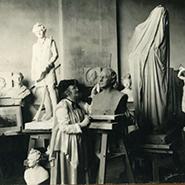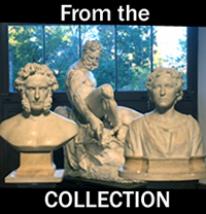Elisabet Ney Biography
Dr. Edmund Montgomery Biography
Early Years
Edmund Duncan Montgomery was born in Edinburgh, Scotland on March 19, 1835. Very little is known for certain about Montgomery's parentage, although the evidence suggests that he was the illegitimate son of Duncan McNeill, Lord Colonsay, a noted Scottish jurist, and a woman named Isabella Davidson or Montgomery. At a very early age, he went with his mother to live for a time in Paris, France and then to Frankfurt, Germany, where he received his early education. As a teenager, he showed an interest in philosophy, going through a short-lived infatuation with the works of Schopenhauer. It was at this time that he dedicated his life to a study of philosophy firmly grounded in the physical sciences.
Education
In 1852, Montgomery entered the University of Heidelberg as a medical student. Here he worked in the laboratory of Robert Bunsen and was introduced into the intricacies of philosophy in the home of Christian Kapp. It was also here that Montgomery met and fell in love with Elisabet Ney, who was in Heidelberg visiting a friend.
After Heidelberg, it was on to the University of Berlin, where Montgomery attended lectures by Johannes Muller, and then to Bonn, where he was very much influenced by Hermann von Helmholtz’s lectures on the physiology of the senses. After a period of clinical work, he received a Doctor of Medicine degree from the University of Wurzburg on Feb. 18, 1858.
Professional Career
After brief internships at Prague and Vienna, Montgomery moved to London, where he became resident physician at the German Hospital and Bermondsay Dispensary. He also began his biological researches in earnest at St. Thomas’s Hospital where he became the Curator of the hospital’s museum and Demonstrator of Morbid Anatomy. His success seemed assured when, in 1862, he was elected to the Royal College of Physicians of London. However, early the next year, he was diagnosed as having tuberculosis.
Montgomery's health problems caused him to set aside his researches for a time. He decided to move to the resort island of Madeira, where he could establish a medical practice and allow his own health to improve. It was here that Edmund Montgomery and Elisabet Ney were married in the British Consulate Office on Nov. 7, 1863. For the next few years, Montgomery spent his time taking care of a sizeable medical practice on Madeira and along the French Riviera, and, as time would allow, he slowly returned to his research work.
In 1867, Montogomery published "On the Formation of the So-Called Cells in Animal Bodies," in which he outlined his objections to the current cell theory. In 1871, he published his major European work, Die Kant’sche Erkenntnisslehre widerlegt vom Standpunkt der Empirie, in which he challenged the philosopher Kant in his own language. Just as this work was being published, and for reasons never fully understood, Ney and Montgomery left Germany to begin a new life in America.
Emigration
After a two-year stay in Thomasville, Georgia, they moved into Liendo Plantation in Hempstead, Texas, with their two young sons and their faithful housekeeper, Crescentia (Cenci) Simath. It was here, in the seclusion of Liendo, that Montgomery did his most significant research. Although he would later be called “the Hermit Philosopher of Liendo,” he nonetheless maintained close contacts with the intellectual circles of Europe and America through publications and personal letters. He was a frequent contributor to numerous philosophical journals, including Open Court, Monist, Mind and New Ideal. In the years 1885, '86 and '87, he submitted papers that were read at symposia at the Concord School of Philosophy, and in 1893, he presented a paper at the Psychical Science Congress in Chicago.
Community Activism
After an initial period of isolation, Montgomery became more active in the Hempstead area, helping to improve the lot of the local citizens. He helped in the founding of Prairie View State Normal and Industrial College (Prairie View A&M). He established a reading club in which topics of the day could be discussed. He also delivered public lectures on various occasions. After becoming a United States citizen, Montgomery became active in local politics, serving two terms as Waller County Road Commissioner. During his time in office, an iron bridge was finally built over the Brazos River, facilitating the marketing of local crops.
Later Years and Works
In 1903, after an association of several years and after having delivered a number of lectures, Montgomery was elected president of the Texas Academy of Science. The next year, he attended the International Congress of Arts and Science in St. Louis, where he was able to hear first-hand all the latest scientific advances. Later in the year, he published "The Vitality and Organization of Protoplasm," his treatise on the nature of life. This was followed in 1907 by his major work, "Philosophical Problems in the Light of Vital Organization," in which he expounded the philosophical consequences of his biological research.
Since 1892, Elisabet Ney had been spending most of her time in Austin, where she had revived her artistic career. In late May of 1907, she suffered a heart attack at her studio. Montgomery rushed to be by her side. There he remained, seeing to her needs night and day, until her death on June 29.
In 1908, Montgomery sold Ney’s studio to her friend and supporter, Ella Dancy Dibrell, and donated her sculptures to the University of Texas to remain on constant display at the studio, now the Elisabet Ney Museum. The same year, he also published his final work, "The Revelation of Present Experience," a condensed and less technical explication of his philosophical system. The next few years saw his physical health and mental acuity gradually decline, as he suffered a number of paralyzing strokes.
Edmund Montgomery died on April 17, 1911, and was laid to rest at Liendo beside his beloved Elisabet in a grove of Live Oak trees, which they themselves had planted almost 40 years earlier.
Bibliographic Information
1. Selected Bibliography: Books on Elisabet Ney and Edmund Montgomery
Cutrer, Emily. The Art of the Woman. University of Nebraska Press, 1988. (University of Texas PHD dissertation and published biography on Elisabet Ney. Ney's life and work in Texas is primary emphasis. Most reliable of publications. Out-of-print but usually available from amazon.com)
Comini, Allesandra. "Who Ever Heard of a Woman Sculptor? Harriet Hosmer, Elisabet Ney and the Nineteenth-Century Dialogue with the Three Dimensional." American Women Artists 1830-1930. Washington, D.C.: National Museum of Women in the Arts, 1987. (Introductory essay)
Fortune, Jan & Jean Burton. Elisabet Ney. New York: Alfred A. Knopf, 1942. (Historical fiction)
Goar, Marjorie. Marble Dust. Austin, Texas: Eakin Press, 1984. (Romance novel)
Heller, Nancy G. Women Artists, An Illustrated History. New York: Abbeville Press, 1987. (Portrayal of Elisabet Ney in context of women artists throughout history)
Keeton, Morris T. The Philosophy of Edmund Montgomery. Dallas, Texas: Southern Methodist University Press, 1950. (Harvard University PHD dissertation and published work on Edmund Montgomery's pioneering philosophical ideas developed on a remote Texas plantation in the late 1800's)
Loggins, Vernon. Two Romantics. New York: Odyssey Press, 1946. (Biography on Elisabet Ney and Edmund Montgomery with detailed information on their lives in Europe.)
Muller, Eugene. Elisabet Ney. Leipzig: Koehler & Amelang, 1931. (In German)
Reiter, J. S. The Woman. New York: Time-Life Books, 1978. (Short seven-page biography)
Rutland, Mrs. J. W. (Willie B.), ed. Sursum! Elisabet Ney in Texas. Austin, Texas: Elisabet Ney Museum, 1977. (Annotated collection of Elisabet Ney's Texas letters compiled by longtime Elisabet Ney Museum curator)
Stephens, I. K. The Hermit Philosopher of Liendo. Dallas, Texas: Southern Methodist University Press, 1951. (Biography on Edmund Montgomery. Valuable information also included on Elisabet Ney)
Taylor, Bride Neill. Elisabet Ney, Sculptor. New York: Devin-Adair Co., 1916. (Reprinted by Thomas F. Taylor, Austin, Texas, 1938) (Loving biography on Elisabet Ney written by Ney's close friend. Based largely on personal experiences and interviews with Elisabet Ney and her devoted circle of friends in Austin, Texas, 1892-1907.)
2. Archival Sources
Austin History Center of the Austin Public Library, Austin, Texas
Eugene C. Barker Texas History Center, University of Texas at Austin, Texas
Fikes Hall of Special Collections and DeGolyer Library, Southern Methodist University, Dallas, Texas
Harry Ransom Humanities Research Center, University of Texas at Austin, Texas
Texas Collection, Baylor University, Waco, Texas
Texas State Archives, De Zavala Collection, Austin, Texas




